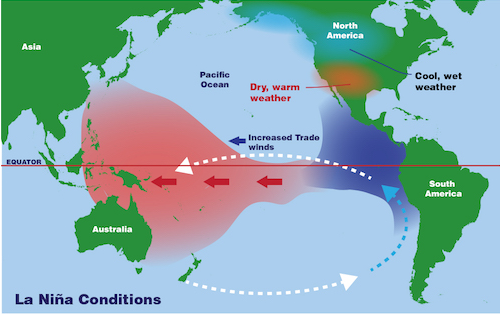El Niño and La Niña represent opposite extremes in the El Niño/Southern Oscillation (ENSO). The ENSO cycle refers to the coherent and sometimes very strong year-to-year variations in sea-surface temperatures, rainfall, surface air pressure, and atmospheric circulation that occur across the equatorial Pacific Ocean.
El Niño refers to the above-average sea-surface temperatures that periodically develop across the east-central equatorial Pacific. It represents the warm phase of the ENSO cycle. La Niña refers to the periodic cooling of sea-surface temperatures across the east-central equatorial Pacific. It
represents the cold phase of the ENSO cycle.

Normal Conditions
What is El Nino?
El Niño is a climate phenomenon characterized by the abnormal warming of sea surface temperatures in the central and eastern equatorial Pacific Ocean. This warming occurs irregularly at intervals of typically two to seven years and can persist for several months to over a year. El Niño events disrupt normal weather patterns across the globe, impacting regional climates, ocean currents, and atmospheric circulation.
During an El Niño event, the warm ocean waters in the central and eastern Pacific Ocean lead to changes in atmospheric circulation patterns. Specifically, the normal trade winds weaken or even reverse direction, causing a decrease in upwelling of cold, nutrient-rich waters along the western coast of South America. This reduction in upwelling disrupts the typical weather patterns, leading to various climate anomalies worldwide.

El Nino Conditions
The impacts of El Niño events vary depending on location, but some common effects include:
- Increased rainfall and flooding in typically dry regions, such as parts of Australia, Southeast Asia, and the western coast of South America.
- Drought conditions in other regions, such as the western United States and parts of Africa.
- Intensification of tropical cyclone activity in the eastern Pacific and decreased activity in the Atlantic basin.
- Shifts in temperature patterns, including warmer temperatures in the northern United States and cooler temperatures in parts of the southern United States and South America.
- Disruption of fisheries, agriculture, and water resources, leading to economic and social impacts in affected regions.
What is La Niña?

La Nina Conditions
La Niña is a climate phenomenon characterized by cooler-than-average sea surface temperatures in the central and eastern equatorial Pacific Ocean. It is essentially the opposite of El Niño, with La Niña events marked by the strengthening of normal oceanic and atmospheric circulation patterns.
During a La Niña event, the trade winds in the equatorial Pacific Ocean intensify, leading to increased upwelling of cold, nutrient-rich waters along the western coast of South America. This enhanced upwelling reinforces the cool ocean temperatures in the central and eastern Pacific.
The impacts of La Niña events on global weather patterns are distinct from those of El Niño and can include:
- Increased rainfall in the western Pacific, leading to flooding in countries such as Australia, Indonesia, and the Philippines.
- Drier-than-average conditions in parts of the central and eastern Pacific, including the western coast of South America.
- Enhanced tropical cyclone activity in the western Pacific, with higher-than-normal numbers of typhoons and hurricanes.
- Shifts in temperature patterns, including cooler temperatures in the northern United States and warmer temperatures in parts of South America and Southeast Asia.
- Effects on agriculture, fisheries, and water resources, with both positive and negative impacts depending on location.
La nina vs el nino weather
| Basis | La Niña | El Niño |
| Ocean Temperature | Cooler than average sea surface temperatures | Warmer than average sea surface temperatures |
| Atmospheric Effects | Strengthened trade winds, increased upwelling | Weakened trade winds, reduced upwelling |
| Precipitation Patterns | Enhanced rainfall in western Pacific, drier conditions in eastern Pacific | Increased rainfall in eastern Pacific, drought conditions in western Pacific |
| Tropical Cyclone Activity | Typically increases in the western Pacific, decreases in the Atlantic | Typically decreases in the western Pacific, increases in the Atlantic |
| Impact on Fisheries | Favorable conditions for fisheries in the eastern Pacific, diminished fisheries in the western Pacific | Diminished fisheries in the eastern Pacific, potential benefits in the western Pacific |
| Global Climate Effects | Cooler global temperatures, potential for more frequent cold outbreaks | Warmer global temperatures, potential for more frequent heatwaves and extreme weather events |
Key Takeaways
- La Niña is a weather pattern that occurs in the Pacific Ocean. In this pattern, strong winds blow warm water at the ocean’s surface from South America to Indonesia. As the warm water moves west, cold water from the deep rises to the surface near the coast of South America.
- El Niño is a weather pattern that occurs in the Pacific Ocean. During this time, unusual winds cause warm surface water from the equator to move east, toward Central and South America. El Niño can cause more rain than usual in South and Central America and in the United States.